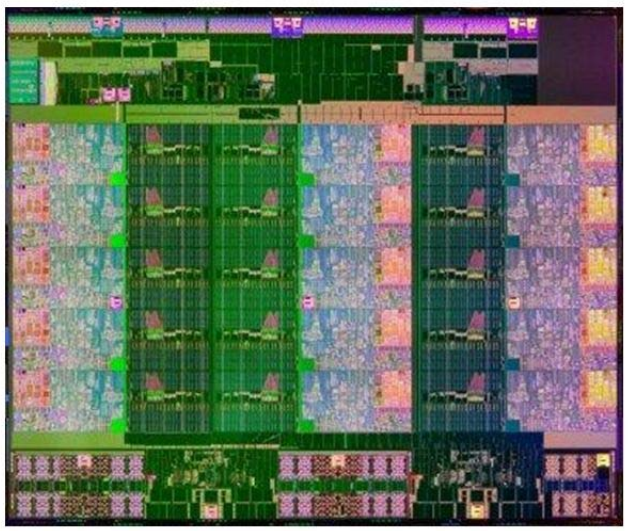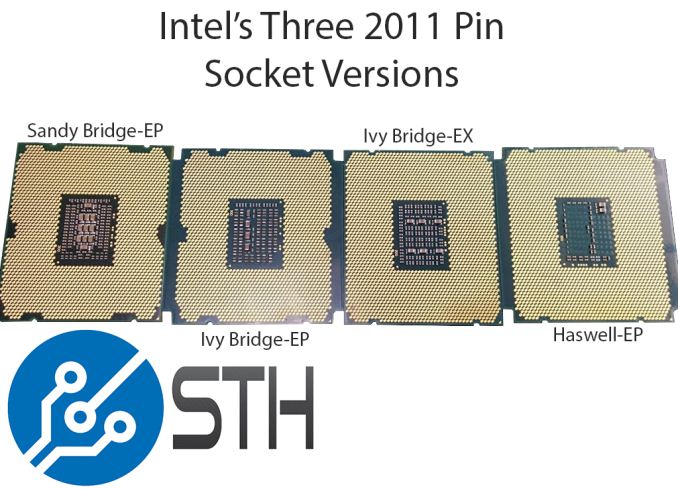Intel’s Three Versions of Socket 2011, Not Compatible
by Ian Cutress on February 20, 2014 9:45 AM EST- Posted in
- CPUs
- Intel
- Xeon
- LGA2011
- Ivy Bridge EX

With our recent discussion regarding Intel’s launch of the 15-core Xeon E7 v2 ‘IvyTown’ processors, thoughts for a lot of high end consumers focused on the underlying hardware for these 4P and 8P systems that would be entering the market. Previously with high end systems there has been a disjunct between the sockets used for the mainstream 1P and 2P processors (-E and -EP) compared to the higher end 4P/8P models (-EX). For example:
With Nehalem/Westmere, the single socket Bloomfield Xeons were LGA 1366.
With Nehalem-EP/Westmere-EP, the dual socket Gainstown Xeons were also LGA 1366.
With Nehalem-EX/Westmere-EX, the quad/octo socket Beckton Xeons were LGA 1567.
With Sandy Bridge-E/Ivy Bridge-E, the single socket Xeons are LGA 2011.
With Sandy Bridge-EN/Ivy Bridge-EN, the single/dual socket Xeons are LGA1356
With Sandy Bridge-EP/Ivy Bridge-EP, the dual socket Xeons are LGA 2011.
With Ivy Bridge-EX, the quad/octo socket Xeons are also LGA 2011, but different.
Reported images of Haswell-EP Xeons also point to LGA 2011, but different again.
Back at ISSCC, when we reported about the talk around the new IvyTown based processors, we lifted the following line from the official documentation:
- “The processor supports two 2011-land, 40-mil pitch organic flip-chip LGA package options”
This produced speculation to whether the processor package for EX would be the same as EP, despite a reconfigured memory controller, additional QPI links and a different pin layout. Given at the time we were under NDA we could not mention they were different, but some investigative work from Patrick at ServeTheHome answers a lot of questions.
Simply put, Ivy Bridge-EP, Ivy Bridge-EX and Haswell-EP all have LGA2011 designations (officially FCLGA2011, for flip-chips), but have different physical mountings in the socket:
Despite the contact patches/‘wings’ on Ivy Bridge-EP, it will fit in the Sandy Bridge-EP socket – the issue is more the pins on Ivy Bridge-EX and Haswell-EP, where on the left and right it is more ‘filled in’, as well as at the corners. The notches for the processors (the indents on the top and bottom) are also different, moving to Ivy Bridge-EX.
The Ivy Bridge-EX and Haswell-EP processors look very similar from these images, despite the extra wings on the Haswell-EP. The key here is the bottom right of the two processors, and count the number of pins between the notch and the edge – Ivy Bridge-EX has four, Haswell-EP has six.
All in all, this may not much of anything – users spending thousands on processors should be making sure that the motherboards they buy have the processor they want listed in the QVL (Qualified Vendor’s List). My concern might be users thinking they can drop a Haswell-EP Xeon into an Ivy Bridge-E, and then trying to force it when it might not fit. Back in previous eras (socket 775 comes to mind) this was an even bigger issue – the processors might fit, but the processors that a motherboard could take was determined by the chipset used by the motherboard manufacturer and the QVL. At least this way the CPUs will not physically fit, but it is something that confuses the situation – it might be worth doing some clever renaming (LGA2011-EX, LGA2011-H), at least from an editorial point of view for the future.
Source: ServeTheHome











47 Comments
View All Comments
chizow - Thursday, February 20, 2014 - link
This is part of the reason I moved off Intel's "Enthusiast" Platform. Far too many delays, incompatibilities, old/lagging tech, and a full year or more off their mainstream performance platform's microarchitecture.Bought two Haswell Z87 builds with 4770Ks and couldn't be happier. The added benefit is that if/when I decide to upgrade either of these builds, they will still make fine HTPCs or thin clients. Unlike the two X58 builds I upgraded from which are completely undesirable in that respect due to their much higher thermals.
JlHADJOE - Friday, February 21, 2014 - link
Ivy Bridge-EX is not part of the "Enthusiast" platform. Right now there's only one socket 2011 anyone not on a big corp's IT team is likely to have to deal with, and that's Sandy/Ivy-E.chizow - Friday, February 21, 2014 - link
Right, this one isn't the Enthusiast platform, but the original 2011 platform is old/aging and was already feature-deficient even at launch (no native USB 3.0, only 2 SATA 6G, no official PCIe 3.0 GPU support). LGA 2011-3 which will support Haswell-E is only slated for later this year, but again, Intel has pushed these dates back numerous times that I simply got tired of waiting for the E platform to catch up to the mainstream performance platform.iwod - Friday, February 21, 2014 - link
Since Most CPU aren't even upgradeable anymore, Why dont they just sell the CPU with the MB.chizow - Friday, February 21, 2014 - link
They have started to do this on the mainstream performance platforms (non-K) with soldered-on BGA chips.g00ey - Wednesday, March 19, 2014 - link
Because firstly, there is a value to be able to configure a system with different CPUs and motherboard types. Even within one generation there are different types of CPU where one CPU is focused on low-budget or low power consumption, another is focused on high per-thread performance and another is focused on high throughput/workload.Secondly, motherboards do break, even within warranty, so it is a considerable value to be able to replace the motherboard without having to replace the CPU. Sometimes the motherboard may come from a bad batch or model revision which would prompt replacing the motherboard with a different model, a model that may not be available with the same type of built-in CPU as the current faulty motherboard.
Thirdly, having a CPU attached to the motherboard would mean that each unit would bind more capital due to the extra cost of the CPU, both for the reseller, the distributor and also for the motherboard manufacturer. That is capital that could be more efficiently allocated to stock other products that better cater for end-users' needs than an utterly expensive built-in CPU on a motherboard.
C.Henrique - Tuesday, September 2, 2014 - link
Now intel announce the X99 chipset for LGA2011-3, I think someone from intel read this post. And specify that LGA2011-3 is not compatible with LGA2011-1 and 2 (names R1, R2 and R3, if not change RX in future) PC´s market is decreasing year after year, is cheap to keep the same socket, change the version and the user needs change the motherboard. Sales!!